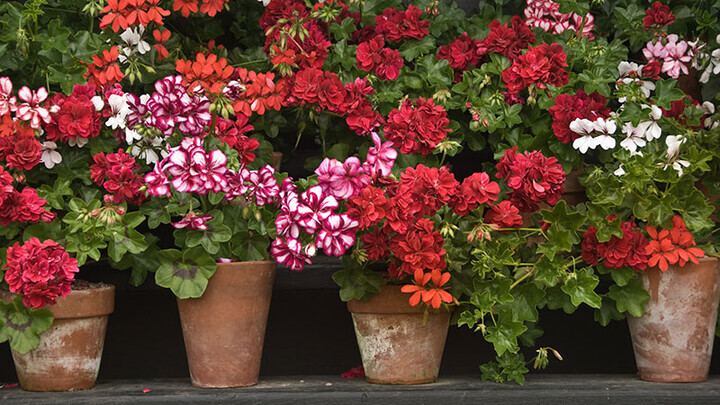You don’t need to be a master gardener to know how to grow geraniums. Geraniums care little for fancy fertilizers or specialized soils, and they require just a bit of basic care to thrive.

·Soil for Geraniums
The perfect soil for geraniums is a loose soil with plenty of organic matter. If your soil is on the heavy side, incorporate peat, compost or perlite. Manure and vermiculite are not recommended.
·Where to Plant Geraniums
You can plant geraniums in almost all gardening zones. Despite knowing this, you may still be asking do geraniums need full sun? Geraniums require plenty of sunlight to flower, but in areas with hot summers, a bit of shade is recommended. When it comes to how much sunlight do geraniums need, the answer depends on the specific geranium and your garden zone. The ideal location has morning sun, afternoon shade and well-draining soil. Choose a properly-sized area for your geranium flower beds. Appropriate spacing in between plants will reduce the risk of disease.
·When to Plant Geraniums
Don’t rush the planting season – geraniums are not cold hardy. But if you wait too long, you risk missing the cool night temperatures that encourage budding. Knowing how to grow geraniums outdoors begins with planting at the proper time. Wait until the danger of the last frost has passed and your soil reaches 60 degrees F.
·Fertilizer for Geraniums
Geraniums require light fertilization. If you feed them too much, the foliage will flourish at the expense of the blooms. Although you may see it in your garden center, you don’t need to purchase a specialty geranium fertilizer. For a gentle fertilization, mix 2 tablespoons of a water soluble 20-20-20 fertilizer into 1 gallon of water. Apply this solution every three weeks throughout the growing season.
Growing Geraniums in Pots
Wondering how to plant geraniums in pots? It’s actually as easy as planting them in the ground. You need loose, well-draining soil, consistent watering and low levels of fertilization.Geraniums grow well in containers of all shapes and sizes, as long as they have drainage holes. The key to successfully growing geraniums in pots is to place them in sunny locations and out of damaging winds.
The added benefit of growing geraniums in pots is that you can simply move pots inside during the winter. When placed in a sunny window, geraniums will thrive as a houseplant even in the coldest months. In spring, gradually move them back outdoors after the last frost.
· Watering Geraniums
Because you need to water geraniums thoroughly and deeply, take the time to leave an irrigation furrow around each plant to serve as a watering reservoir. This allows the water to pool and then gently filter down through the soil. To avoid root rot, allow soil to become dry between watering. Watering at ground level with a soaker hose keeps water off the foliage and protects against disease.Soil in pots tends to get warm, so growing geraniums in containers requires regular watering. The drainage holes help prevent root rot, so you don’t have to wait for the soil to dry out in between waterings.
How much water do geraniums need? It’s going to require simply watching your plants. For proper geranium plant care, avoid letting your geraniums to wilt. Cycles of wilting and revival will result in poor flower production and the dropping of leaves.
·Pruning Geraniums
Annual geraniums that are planted outdoors don’t require pruning, but regular deadheading can help prevent disease and increase production. Simply pinch off the entire flower stalk after the flowers fade and remove dry leaves from the plants.The geranium houseplant tends to become long legged and thin. Regularly prune by pinching the growing points to encourage branching.
·Common Pests and Diseases for Geraniums
The majority of insects and other pests avoid geraniums. However, botrytis and other fungus attacks can occur during cooler, wet weather. Commercial fungicides provide some protection. Overwatering can cause problems such as oedema and root rot.